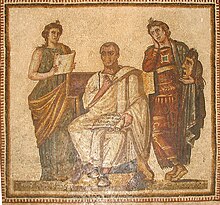Hadrumetum
 | |
| Location | Tunisia |
|---|---|
| Region | Sousse Governorate |
Hadrume(n)tum (sometimes called Adrametum or Adrametus) was a Phoenician colony that pre-dated Carthage and stood on the site of modern-day Sousse, Tunisia. Greek writers referred to Hadrumentum by the names Ἀδρούμητος, Ἀδρύμης and Ἀδραμητός.
History
Antiquity
In the 9th century BC, the Phoenicians, astute Levantine maritime traders who would later be supplanted in Northern Africa by their major colony Carthage, sensed the possibilities of a port city south of present-day Tunis and founded Hadrumetum on what is now the Gulf of Hammamet in the Mediterranean Sea, which flourished before Carthage.
Hadrumetum was one of the most important communities within the Roman territory in northern Africa because of its strategic location on the sea in the heart of the fertile Sahel region. The city allied itself with Rome during the Punic Wars, thereby escaping damage or ruin and entered a relatively peaceful 700-year stint under Pax Romana, although Hannibal made use of it as a military base in his campaign against Scipio Africanus at the close of the Second Punic War. Many records have been found that say the Romans sent a garrison of 5000 soldiers to protect it. They were led by General Septus Loriinus. At some point during this period, the community's name was slightly altered (by the addition of an N) to become Hadrumentum.
Under the Roman Empire, Hadrumetum became very prosperous; Trajan gave it the rank of a colonia: "Colonia Concordia Ulpia Trajana Augusta Frugifera Hadrumetina". A breathtaking legacy of intricate Roman mosaics survives from this era, together with many early Christian objects from the catacombs. At the end of the 3rd century it even became the capital of the newly made province of Byzacena (modern Sahel, Tunisia).
In the early 5th century the city was renamed Honoriopolis after the western emperor Honorius, and later in the 5th century it was destroyed and rebuilt by the Vandals, who renamed it Hunericopolis after their king Huneric.[1] The following century it was retaken by the Romans (or Byzantines) and renamed Justinianopolis after eastern emperor Justinian I.
Later history
By the mid-7th century, Hadrumetum was under Eastern Roman control. During the next 200 years, Hadrumentum became the primary sea port of the Suleiman dynasty, located 60km east of their capital Kairouan ('al-qayrawān in Arabic), renamed Sūsa. The 'ribat', which they began building in 821, as a fortress against the Christians of Sicily, still stands, and contains what is considered to be the oldest mosque in North Africa; nearby, the town's main mosque, also founded in the 9th century, has a similarly fortress-like appearance. In 827 the Aghlabids launched their invasion of Sicily from this port (the first move in a campaign which was to last until 902).
During the 12th century Sūsa was briefly occupied by the Normans (from their territory in Sicily, which they conquered between 1060 and 1090); in the 16th century it was conquered by Ottoman Turks. The city was bombarded by French and Venetian forces during the 18th century. Tunisia had become a French protectorate in 1881, and in the late 19th century, France added to the port's facilities, increasing the importance of Sousse, as it had become by then.
Susa under French rule had 25,000 inhabitants, of whom 10,000 French and 5,000 other Europeans, mainly Italians and Maltese. It was a government centre in the Province of Tunis. It has a few antiquities and some curious Christian catacombs. The native portion of the town has hardly altered. It has a museum, a fort, an important harbour and many oil wells in the neighbourhood.
Ecclesiastical history
Between 255 and 551, in the former Roman province of Byzacena, there were nine bishops of Hadrumetum who are still known. The last of these clerics was Primasius, whose works are to be found in P.L., LXVIII, 467.
Titular see
It was nominally revived as a Roman Catholic titular bishopric of the lowest (episcopal rank) for
- Raphael de Figueredo (1681.05.14 – 1695.10.12), Coadjutor Apostolic Vicar of Malabar (India) (1677 – 1684.07.16), succeeding as Apostolic Vicar of Malabar (1684.07.16 – 1695.10.12).
After a long vacancy, it has had several, almost-consecutive incumbents, also episcopal :
- Salvator-Alexandre-Félix-Carmel Brincat (1889.05.12 – 1909.04.02)
- Giacinto Gaggia (1909.04.29 – 1913.10.28) as Auxiliary Bishop of Brescia (Italy) (1909.04.29 – 1913.10.28), succeeding as Bishop of Brescia (1913.10.28 – 1933.04.15), later also Titular Archbishop of Trajanopolis in Rhodope (1930.03.29 – 1933.04.15)
- Jean-Marie Bourchany (1914.01.13 – 1931.11.27)
- Carlo Re, Consolata Missionaries (I.M.C.) (1931.12.14 – 1951.12.29)
- Jorge Manrique Hurtado (1952.02.23 – 1956.07.28) as Auxiliary Bishop of La Paz (Bolivia) (1952.02.23 – 1956.07.28); later Bishop of Oruro (Bolivia) (1956.07.28 – 1967.07.27), Metropolitan Archbishop of above La Paz (1967.07.27 – 1987.02.24)
- Celestin Bezmalinovic, Dominican Order (O.P.) (1956.08.07 – 1967)
- Mijo Škvorc, Society of Jesus (S.J.) (1970.06.16 – 1989.02.15)
- Marian Błażej Kruszyłowicz, Conventual Franciscans (O.F.M. Conv.), Auxiliary Bishop emeritus of Szczecin–Kamień (1989.12.09 – ...).
References
- ^ O. Maenchen-Helfen, The World of the Huns. IX. footnote 113.
Sources and external links
 This article incorporates text from a publication now in the public domain: Herbermann, Charles, ed. (1913). Catholic Encyclopedia. New York: Robert Appleton Company.
This article incorporates text from a publication now in the public domain: Herbermann, Charles, ed. (1913). Catholic Encyclopedia. New York: Robert Appleton Company. {{cite encyclopedia}}: Missing or empty|title=(help) [1]- Encyclopaedia of the Orient: Sousse (Sūsa)
- Adventures of Tunisia: A virtual tour of the historic sites of Sousse
- GigaCatholic, with titular incimbents lists and linked biographies


